Tillandsia queroensis, was chartacea var. peruviana
Click thumbnails for full size, scaled to a new window.
Tillandsia queroensis
Colombia, Ecuador, Peru. Named by L.B.Smith as chartacea var. peruviana.
Version in Australia still under investigation.
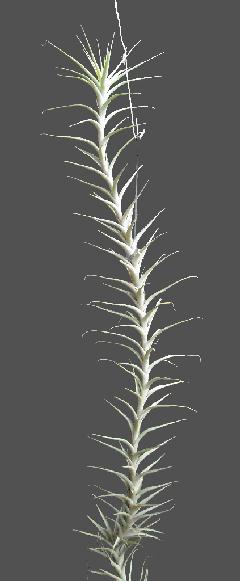
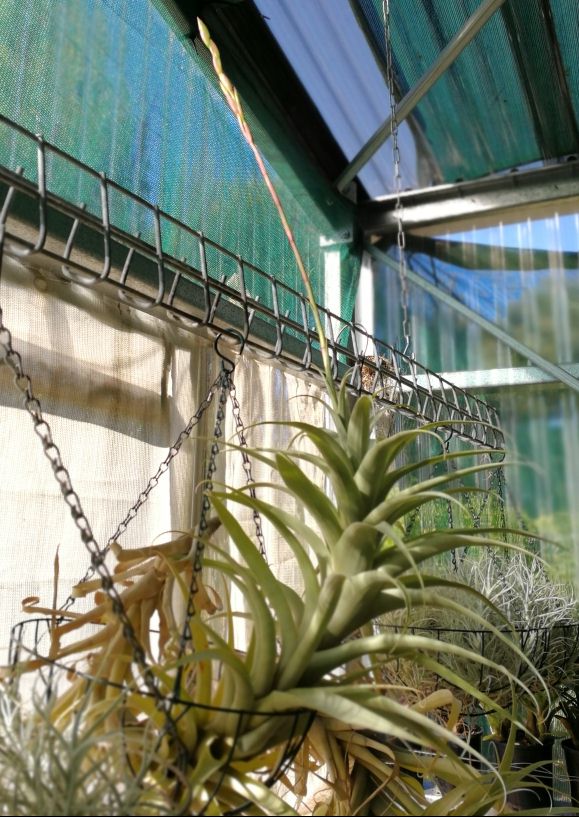
| Ken Woods 07/09 Photo by Geoff Breen. chartacea? |
Justin Lee 03/18 |
Ken Woods (2009) ... "Imported by David Sheumack 15/20 years ago (and one flowered), yet to flower for me. Was 2m long, but 0.5m cut off to find somewhere to hang it !"
Derek Butcher : "It is indeed rare which is why I think your plant is T. queroensis and thus linked to T. incarnata. See the DVD. Harry Luther considers that there is a cline between the two species. This means you can identify T. queroensis at one end of the scale and T. incarnata at the other end but you have problems if your plant is somewhere in between!
Justin Lee (2018) ... "First flowering of T. queroensis (syn chartacea var. peruviana). I think I will have to lower the plant or the spike is going to hit the roof of the greenhouse not to mention that I will be able to get a better look at it."
Tillandsia chartacea and I. . . . . . . . . . by Derek Butcher.
From J. Brom. Soc. 1990 #4
This story starts with me as a pseudobotanist studying Cactaceae genus Copiapoa in the 1970s. This group of plants comes from the coastal areas of the northern portion of Chile close to, if not within, the Atacama desert where rainfall is virtually nonexistent and plants survive on mists created by the Humboldt Current. Growing this genus of plants in Adelaide was a challenge because in Adelaide there are hot and dry summers, cold and wet winters, and very few mists. Further, because importation is not encouraged, seed raising is a popular way of increasing your plant collection.
These endeavours with seed led me to write to Karel Knize, a German-speaking expatriate Czech whose base was Lima, Peru, but who rode the barren wastes on a motor bike collecting seed. The seed I purchased was fresh and germinated well. In broadening my outlook from cactus I found that other plants grew in that arid area, in fact, some grew on plants and some in sand dunes with apparently no root systems. Oddly enough, as my interest turned towards tillandsias so too did that of Karel Knize. Cactuses could be grown from seed with a bit of trial and error so why not tillandsias? My optimism was jolted and although to this day I still try tillandsia seed I cannot say that my success rate has been encouraging.
In 1978 I took the plunge and imported tillandsias from a cactus expert into a country where the quarantine authorities were just getting accustomed to tillandsias. Trying to work out names was an interesting project. I still have unnamed species yet to flower and species that seem to key out halfway between known species; for example, one with flower structure of Tillandsia paleacea and plant structure of Tillandsia purpurea.
I also had a plant named Tillandsia multiflora that under my conditions became caulescent, so much so that I believed I had a large form of T. cauligera. After all, T. multiflora was supposed to have no stem, as such.
On and on the plant grew and then suddenly a flower spike emerged and grew at a similar rate. It, too, didn't seem to know when to stop but eventually did and after some agonising few weeks decided to flower.
It was not Tillandsia multiflora or T. cauligera or even a large form of T. latifolia. In disgust at my lack of naming prowess I removed the required portions and sent them to Harry Luther for naming.
Back came the reply: Tillandsia chartacea. With immediate referral to Smith & Downs I was able to confirm. How could I have missed this when working diligently through the keys? How could I have missed this when I gave up on the keys but read every species in the book?
Tiliandsia chartacea was named by Dr. L.B. Smith in 1951 for its papery floral bracts. The plant is short-caulescent, flowering nearly 1 meter high. Leaf sheaths are elliptic to 8 cm in length with the blades narrowly triangular to 3 cm in width, all densely silver lepidote. The scape is erect, the upper portion red. The inflorescence is pinnate, petals linear, erect to slightly spreading, obtuse; white with dark pink H.E.L. says that the petals look purple in the photo; stamens included.
There are two recognised varieties, one from Colombia named variety chartacea. The other, from Peru, is named variety peruviana with no reported sightings in Ecuador. I assume that Knize's range of influence would more likely encompass Peru than Colombia and thus mine is more likely to be the Peruvian variety.
This is a vigorous species growing well in Adelaide conditions with a little protection from the sun. It appears to enjoy the cold, wet winters, which are its main growing period. After flowering it offsets profusely producing a new plant from virtually every leaf axil. It has certainly found one ecological niche here in South Australia.
Note added 1996
In An Alphabetical list of Bromeliad Binomials 5th Edition April 1996 we first saw T. chartacea v. peruviana being considered a synonym of T. queroensis. This was confirmed in De Rebus Bromeliacearum II in Selbyana 18 (1997). At the same time I imported this alleged Tillandsia multiflora (now a Racinea) I had a similar looking plant which turned out to be Tillandsia cerrateana which also comes from near Chiquian in Northern Peru. There is a great chance that Knize collected both plants in this area. I have, therefore, changed the name on my plant to Tillandsia queroensis.
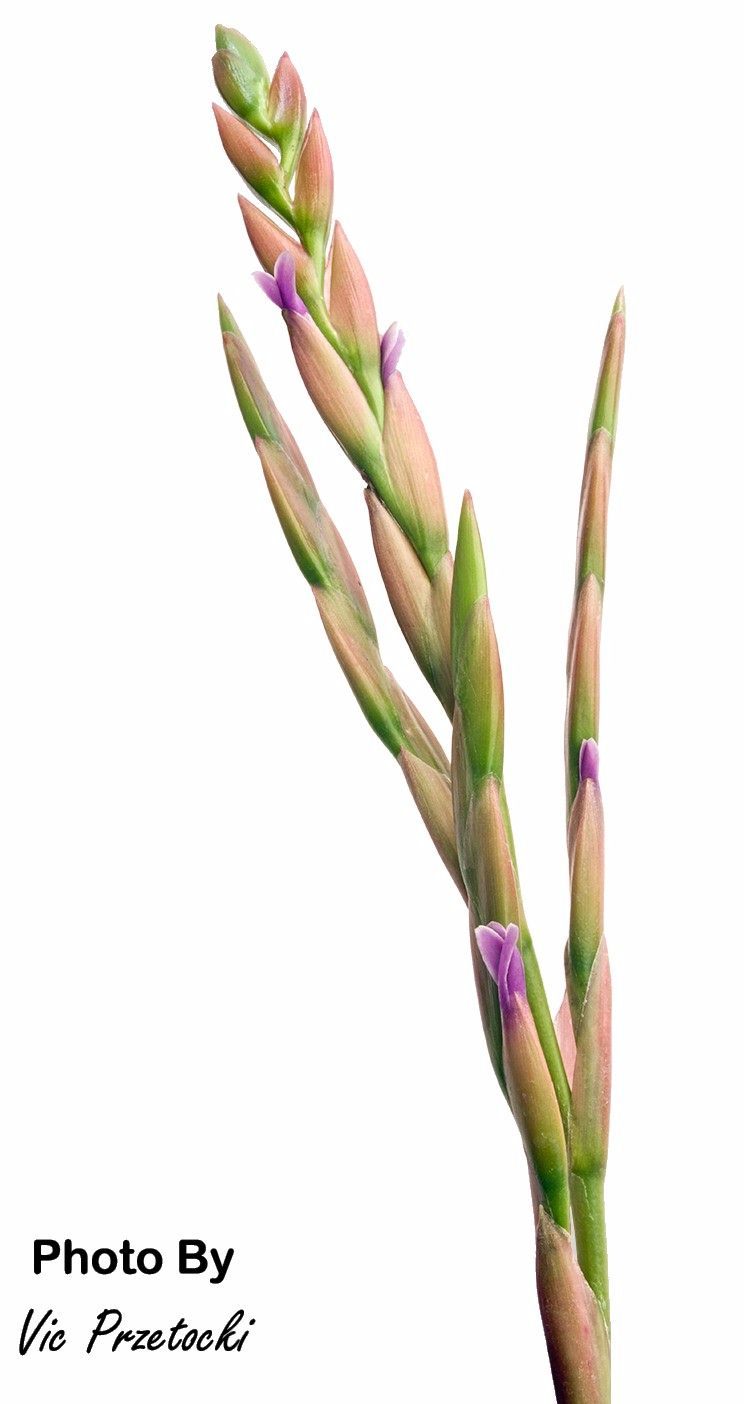
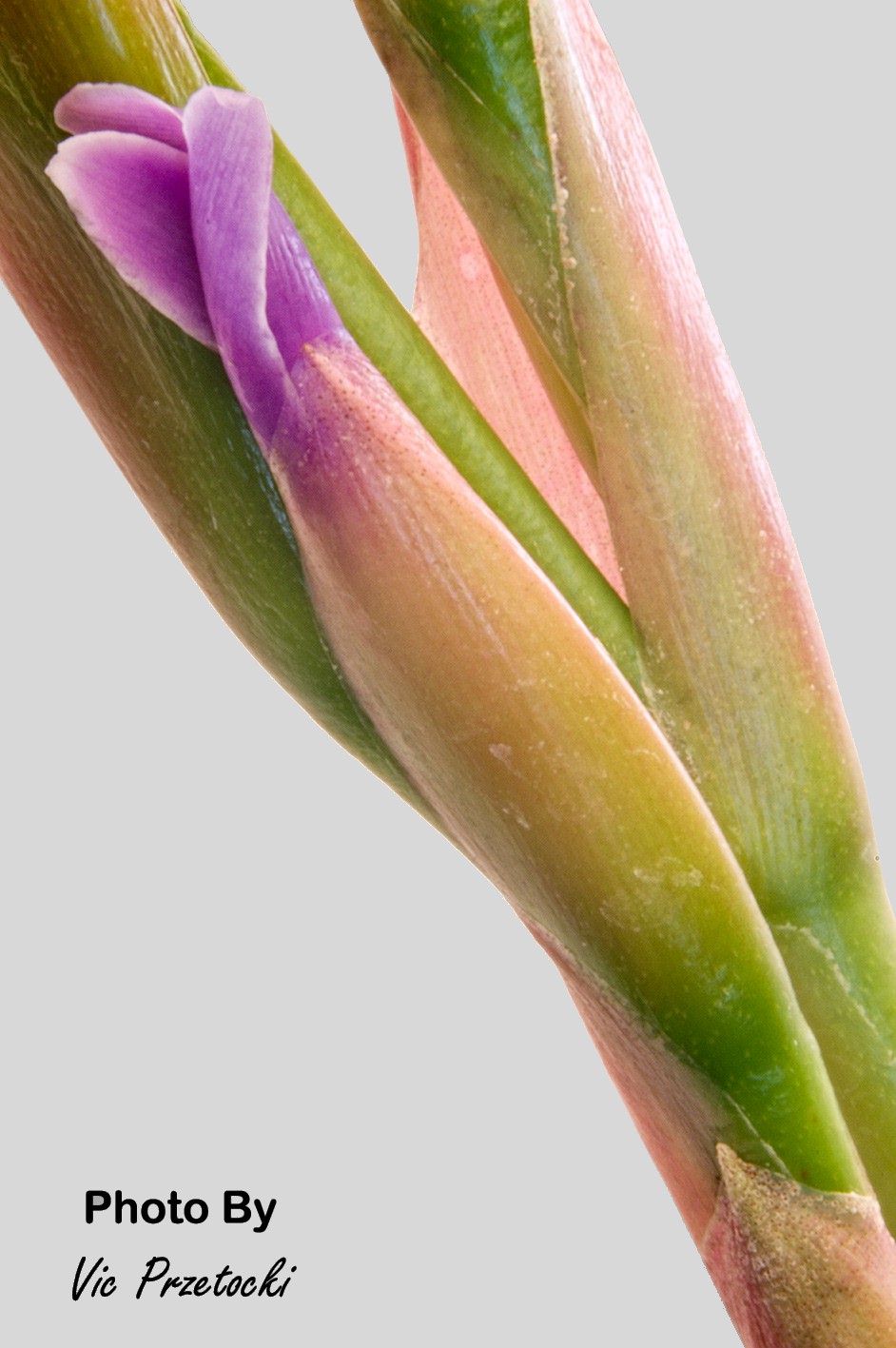
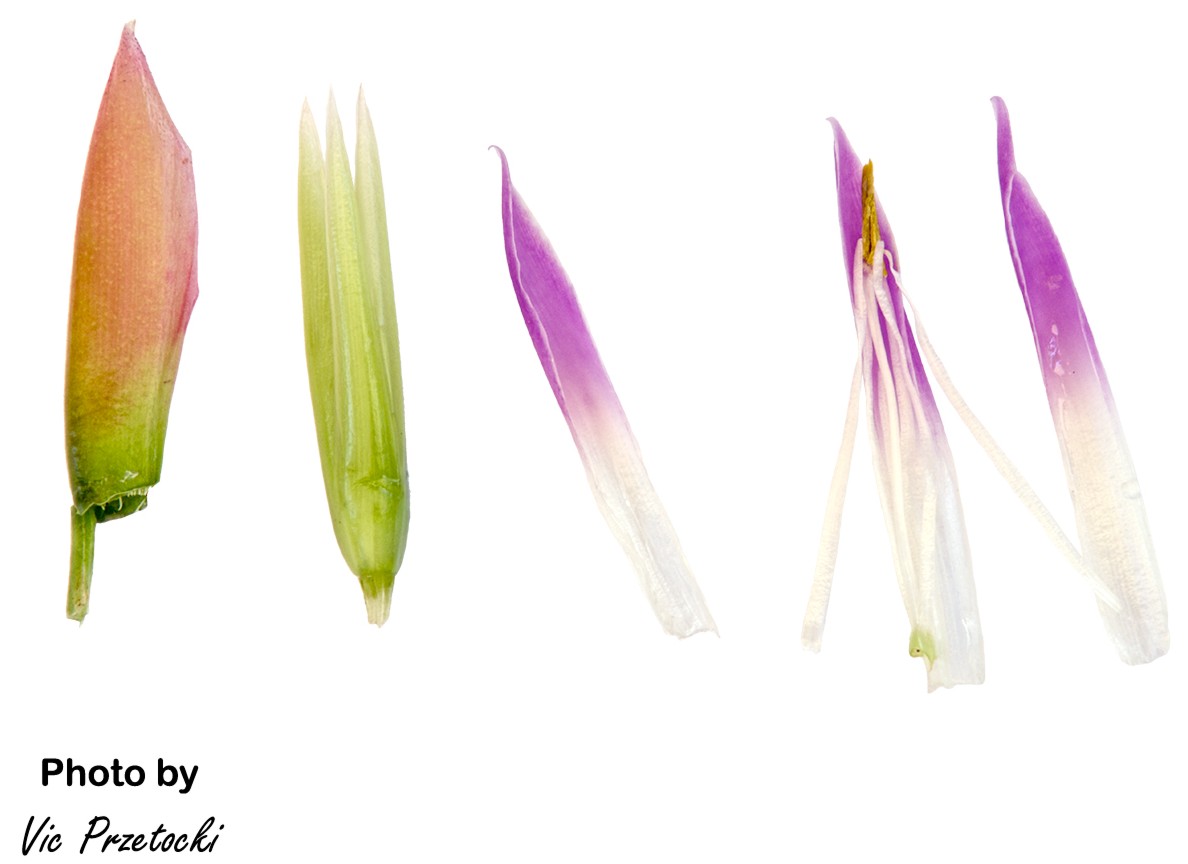
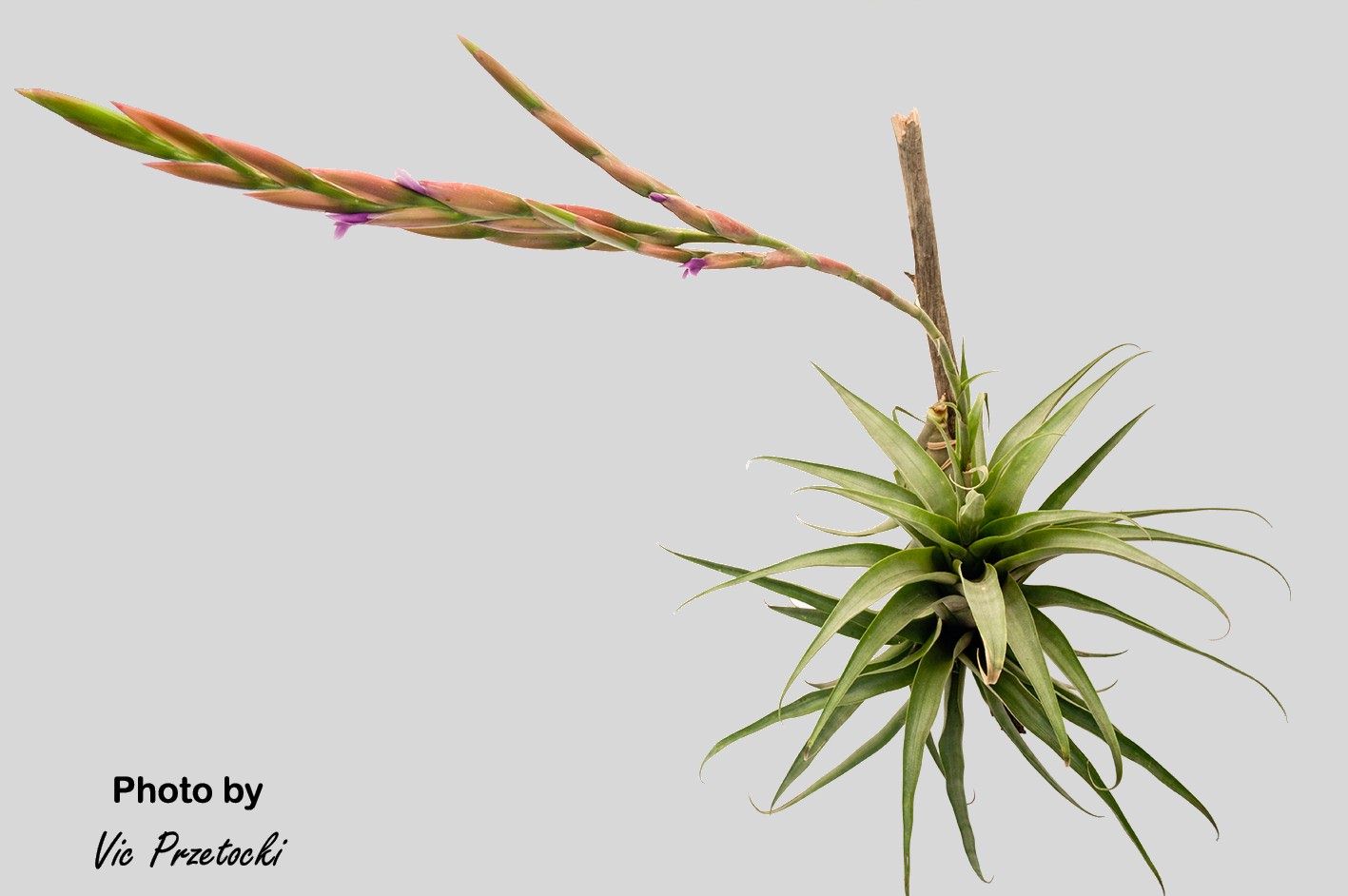
Vic Przetocki ... "Plant entered WA via another grower as Tillandsia chartacea but was thought to be T. queroensis. Tried keying the plant out for ID, comes out close to Till. queroensis. Only half of the plant is showing in the photo, a Tillandsia growing above it fell on it breaking the plant in half, full plant length would have been 80 cm, the flower spike is 66 cm long. The broken off lower half of the plant has produced 2 shoots."
Chris Larson ... "See Dereks document above. Justin brought this one up a couple of months ago & it sort of just passed. I’ve been told by others comparing it to descriptions that it was close, but definitely not (pers comment). So, it is distributed across most states. Seems like it needs to be registered with a name."
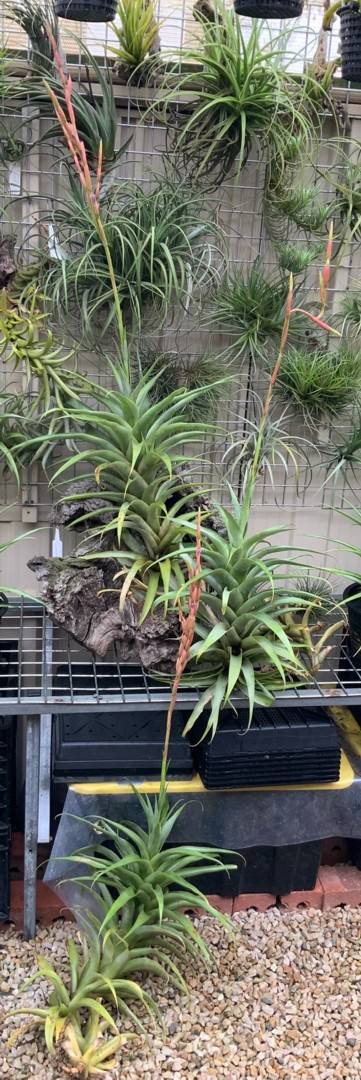
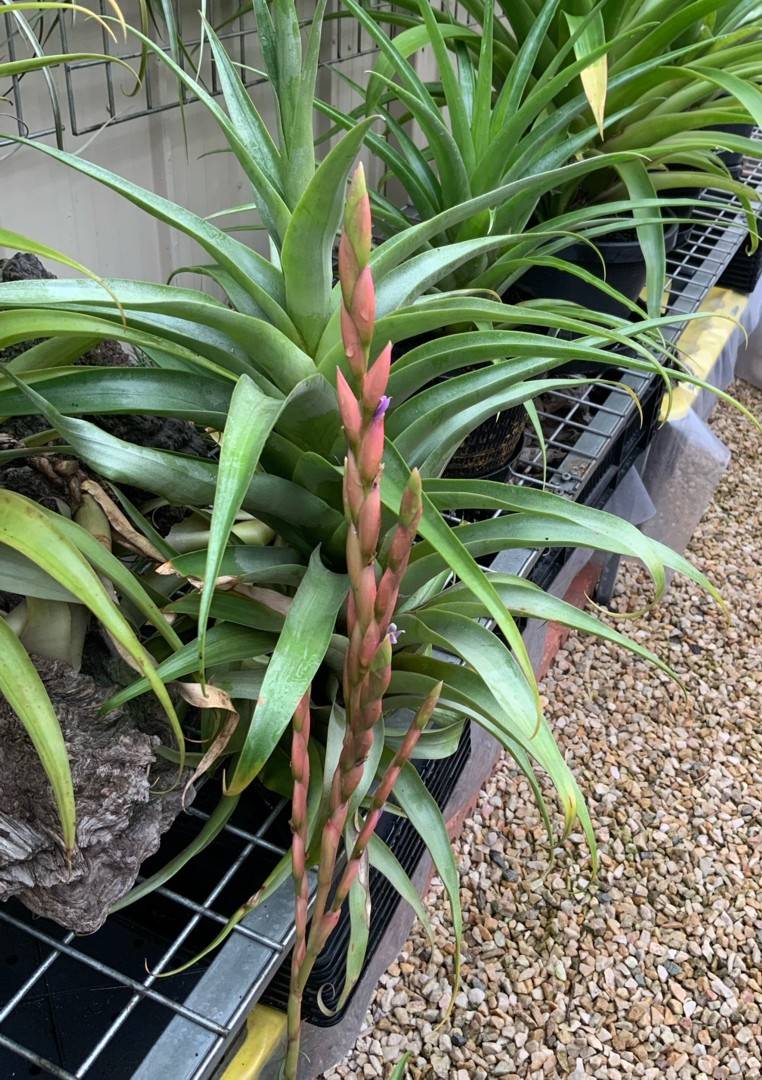
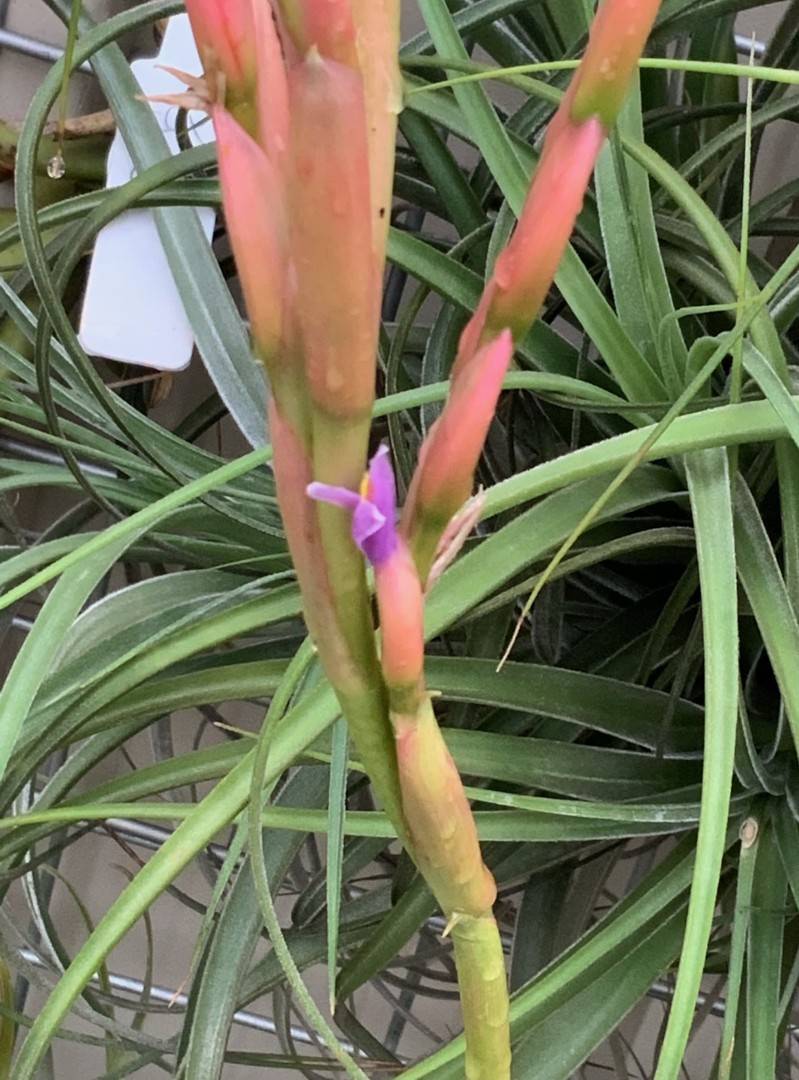 Ray Clark ... "This one is labelled as T. queronensis as chartecea v. peruviana. It got a little big for its perch after a massive 5.2mm of rain this afternoon. No complaints, quite a hardy plant and long lasting flower spike."
Ray Clark ... "This one is labelled as T. queronensis as chartecea v. peruviana. It got a little big for its perch after a massive 5.2mm of rain this afternoon. No complaints, quite a hardy plant and long lasting flower spike."
Peter Tristram ... "Hi Ray: This is a big, caulescent plant from Knize, so from some cliffs in Peru somewhere. For me the stems can easily exceed 2m. requiring sectioning, before blooming. Yes, it's had a couple of names over the years. I sent material to Eric, after the chartacea discussions many moons ago, who declared it species nova, with which I agree. I have a few forms too, from straight to undulating leaves, greener to quite silvery, that turned up over the years.
A stroll through the dvd could confuse you even more, though the history of Derek's involvement is written there, as well as various others. Lumping was at play imho. It's a great plant, whichever clone you have and deserving of taxonomic attention... one day."
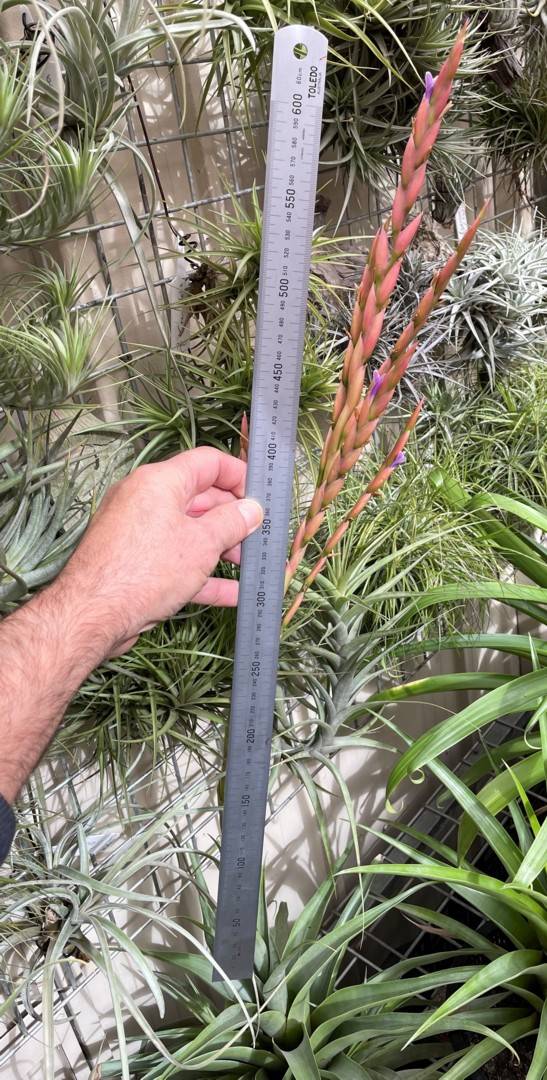
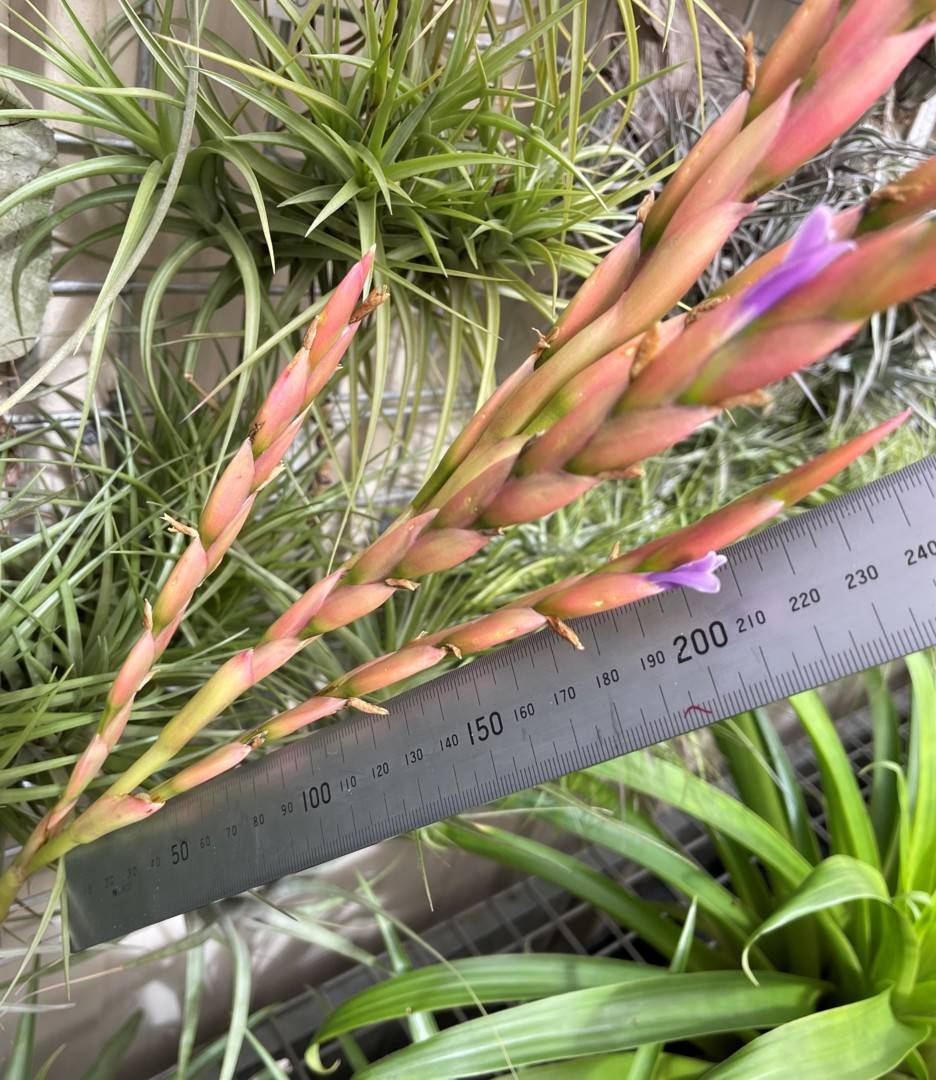


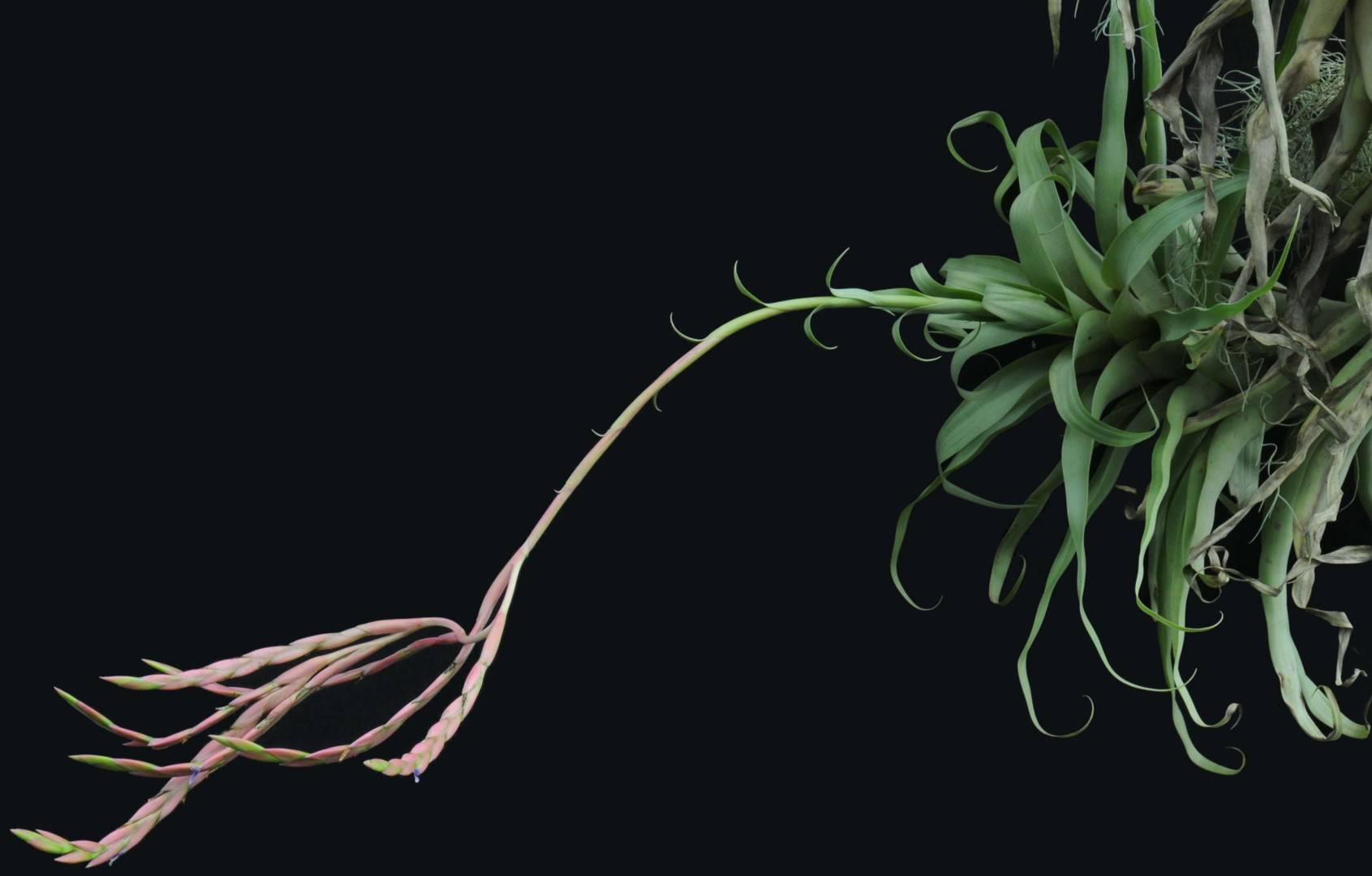 . .
. .
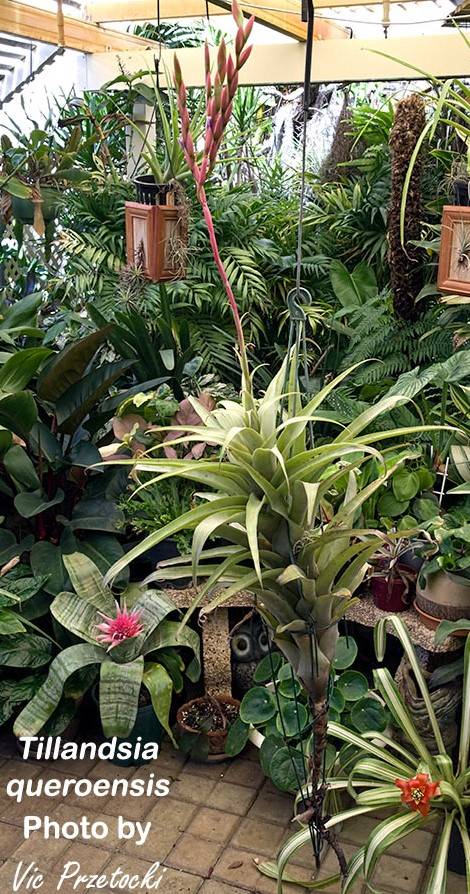
| Peter Tristram 05/22 as 'sp. nova Peru' ex. Derek Butcher |
Vic Przetocki 04/23 "thought to be queronensis" |
Ray Clark to Eric Gouda 1/5/2022 ... "Hi Eric, Peter Tristram indicated that you had considered this plant to be species nova, will it be published or registered? If I can assist with any details please let me know."
Eric Gouda ... "It could be new all right. To describe a species I need at least one specimen and if possible a duplicate (inflorescence and some leaves) for the type to be deposited in the land of origin. And of course to make the description / find out if it is really new."
Peter Tristram ... "This plant has been discussed a lot!
I'll try to remember to get some pics of one I also have in bloom tomorrow. It is a regular bloomer for me and sure gets big and long. I have the clone from Derek Butcher (Ray's plant I assume) as well as a few others from Knize. They have various degrees of leaf waviness and waxiness with one having straight leaves, but the spikes are all very similar. Attached are pics taken in 2011 of Derek's version. I'd have other pics of the KK versions but not archived – tomorrow, hoping flowers are out. I have no idea where Karl Knize obtained them though."
Ray Clark ... "Yes Peter, you are correct in your assumptions. My plant came from Derek who got it from Mr. Knize in 1981. Attached are more pics of my plant complete with approximate dimensions"
Rob Bower ... "Peter: I have a similar quite large form of charteacea that I got from you a while ago. I also have a much smaller more slender form – also from you. Do I gather from the email trail that you think it may be another species. I'v never seen the slender form flower."
Tillandsia queroensis Gilmartin, Phytologia 16: 159. 1968.
A T. orbicularis L B Smith atque T. sceptriformis Mez et Sodiro, cui affinis, caulibus elongates, foliorum laminis triangulates, spici filiformibus paucioribus differt.
Tillandsia chartacea var peruviana L. B. Smith, Phytologia 4: 218. 1953 (See Binomials #5 1996
Desc from S&D p792-3
Plant caulescent, flowering 7-10 dm high; stems long, branching.
Leaves 30-45 cm long;
Sheaths 10 cm long, 4-5 cm wide, dark brown;
Blades narrowly triangular, filiform-attenuate, densely appressed-lepidote.
Scape curved, exceeding the leaves, 5-6 mm in diameter;
Scape-bracts erect, imbricate, red.
Inflorescence bipinnate from 4-6 spikes, dense toward apex, 10-24 cm long, 3-4 cm wide;
Primary bracts erect, elliptic, acute to apiculate, shorter than the spikes, red;
Spikes erect, subsessile with 1-2 sterile bracts at base, oblong or linear, 55-70 mm long, 15 mm wide, complanate, 5-9-f1owered.
Floral bracts laxly imbricate, elliptic-ovate, broadly acute, 25 mm long, with little or no keel, nerved, glabrous or sparsely lepidote outside.
Sepals elliptic, acute, 17-22 mm long, the posterior carinate, connate for 1-5 mm, glabrous outside.
Petals 30-35 mm long, 2-3 mm longer than the stamens.
Type. Gilmartin 1102 (holotype US), at km 18, Ambato to Cuenca, near pueblo of Quero, 1°23' S, 78°36' W, Tungurahua, Ecuador, 8 Aug 1965.
Distribution. Terrestrial on steep rocky slopes, 2500-2800 m alt, Ecuador. ECUADOR. TUNGURAHUA: type locality, 8 Aug 1965, Gilmartin 1101 (US). CANAR: Valley of Azogues, Naundorff s n cult. Marnier-Lapostolle (US).
NOTES from Gilmartin, Phytologia 16: 159. 1968.
The floral parts when dry bear some resemblance to T. incarnata H. B. K. However, the inflorescence is borne on a much thicker scape and is bipinnate, the floral bracts are broader, 1.0-1.3 cm wide, and the sepals are larger, 1.7- 2.2 cm long and less connate, 3-5 mmm, in T. queroensis than in T. incarnata. The colors of the live inflorescence are distinct, the floral bracts being red in T. queroensis and purple in T. incarnata. T. queroensis also has some resemblance to T. chartacea L. B. Smith. The primary bracts of T. queroensis, however, are much more conspicuous, being at least, one-half as long as the few-flowered spikes; the spikes are much less complanate and the floral bracts are acute, not obtuse.
98b. Tillandsia chartacea var peruviana L. B. Smith, Phytologia 4: 218. 1953.
Desc from S&D
Floral bracts subdense and partly exposing the rhachis.
Sepals 16 mm long.
TYPE. Cerrate 454 (holotype US, isotype USM), Timpoc, 4 km below Chiquian, Bolognesi, Ancash, Peru, 3 Aug 1949.
DISTRIBUTION. On dry rocky soil, 2500-3200 m alt, Ancash, Peru.
PERU. ANCASH, Bolognesi: Chiquian, 6 Aug 1949, Cerrate 307 (US, USM); Ferreyra 6213 (US, USM).
During the dry season this plant provides good cattle feed.
LOCAL NAME. Hueglia or Hueccla
Tillandsia chartacea L. B. Smith, Contr. U. S. Natl. Herb. 29: 437, fig. 42 d, e. 1951.
Desc from S&D p761-2
Plant short-caulescent, flowering nearly 1 m high.
Leaves 25-35 cm long;
Sheaths elliptic, to 8 cm long, covered with brown appressed scales;
Blades narrowly triangular , caudate-attenuate, to 3 cm wide, covered with appressed cinereous scales with brown centers, somewhat plicate.
Scape erect, elongate, 6 mm thick, glabrous;
Scape-bracts strict, densely imbricate and closely enfolding the scape, the lower foliaceous, the upper broadly elliptic, long-caudate, red.
Inflorescence subdigitate;
Primary bracts like the upper scape-bracts but merely apiculate, very much shorter than the spikes;
Spikes suberect, linear, strongly complanate, 11-13 cm long, 15-20 mm wide, 10-17-f1owered.
Floral bracts elliptic, dense, obtuse, ecarinate, 28 mm long, exceeding the sepals, chartaceous, nerved, subdensely lepidote with cinereous brown-centered scales; pedicels short and stout.
Se¬pals linear-lanceolate, 22 mm long, nerved, carinate and much connate posteriorly, lepidote;
Petals linear, obtuse; white with dark pink blade;
Stamens included, filaments plicate near apex.
Type. Foster 1802 (holotype GH, isotype COL), on rocks, Suesca, 2580 m alt, Cundinamarca, Colombia.
DISTRIBUTION. Known from the type collection only.
Smith’s original comments
Its plicate filaments indicate that Tillandsia chartacea is probably most closely related to T. incarnata H. B. K., and the leaves, spikes, and floral bracts are also similar although much larger. These two species would be widely separated in Mez's system since he makes a major division on the highly artificial character of the amount of branching of the inflorescence.
98b. Tillandsia chartacea var. peruviana L. B. Smith, Phytologia 4: 218. 1953.
Desc from S&D
Floral bracts subdense and partly exposing the rhachis.
Sepals 16 mm long.
TYPE. Cerrate 454 (holotype US, isotype USM), Timpoc, 4 km below Chiquian, Bolognesi, Ancash, Peru, 3 Aug 1949.
DISTRIBUTION. On dry rocky soil, 2500-3200 m alt, Ancash, Peru.
PERU. ANCASH, Bolognesi: Chiquian, 6 Aug 1949, Cerrate 307 (US, USM); Ferreyra 6213 (US, USM).
During the dry season this plant provides good cattle feed.
LOCAL NAME. Hueglia or Hueccla
Tillandsia chartacea var peruviana L. B. Smith, Phytologia 4: 218. 1953. Now treated as T. queroensis See Binomials #5 1996
Updated 23/04/23













 . .
. .
